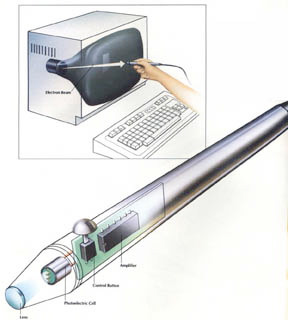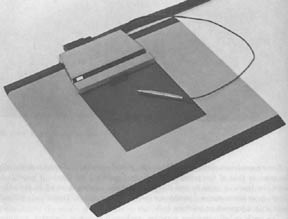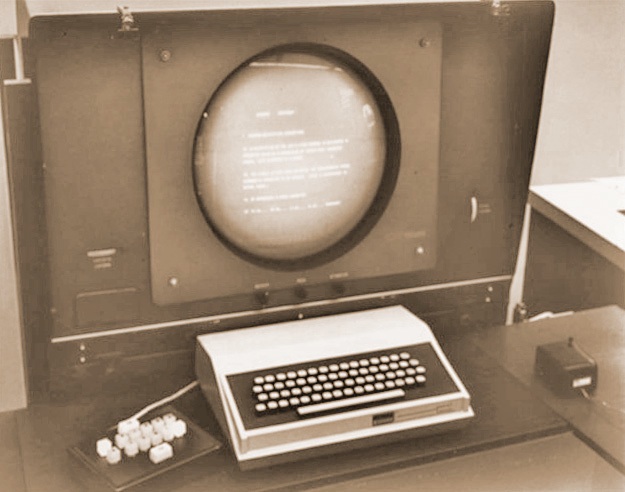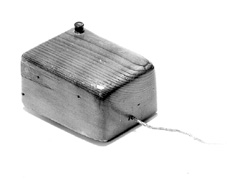Chapter 3: The computer graphics industry evolves
3.5 Input devices

Input devices were also a very important part of the systems that were evolving during this early part of CG history. As mentioned earlier, typical input was accomplished with an alphanumeric terminal, function buttons and/or dials, and the light pen (or light pencil, in the case of the DAC-1 system). Also, the DAC-1 system pioneered the use of photographic input (what would later give rise to scanning technology.) The joystick was adapted to provide numerical input.

Tom Dimond patented an approach to handwriting recognition in 1957 that utilized an innovative tablet that detected the regions of interaction, giving rise to the graphics tablet. Sylvania introduced a tablet that operated on analog voltage principles. One of the most innovative input approaches at the time was manifested by the Rand Tablet. It consisted of a matrix of crossed conductors. The circuitry of the tablet used switching techniques to apply pulses to the conductors in sequence, thus coding their individual locations. When a stylus was touched to the surface of the tablet, it picked up pulses capacitively from the closest of the horizontal and vertical conductors which was converted into an (x,y) coordinate value. The tablet was marketed commercially as the Grafacon tablet, and was often bundled with early DEC computers. It was priced around $18K.

A variation on the graphics tablet approach to input was the sonic pen input tablet introduced in 1970. This technology used three microphones, positioned perpendicularly in the same configuration as the cartesian coordinate axes. A stylus generated a sound, for example with a spark generator, and the position was determined by the triangulation of the distances determined by the microphones. A three dimensional (x,y,z) coordinate resulted from the input. The sonic pen device shown here being used by Charles Csuri was developed at The Ohio State University, and it is being used here to control an image on the screen of a Vector General graphics display behind it. It was also used to “trace” three dimensional objects or paths.

In 1963, Douglas C. Englebart was working at the Stanford Research Institute. He set up his own research lab, which he called the Augmentation Research Center. Throughout the 1960s and 1970s his lab developed an elaborate hypermedia groupware system called NLS (oNLine System). NLS facilitated the creation of digital libraries and storage and retrieval of electronic documents using hypertext. NLS used a new device to facilitate computer interaction — the mouse. The design of the mouse included two opposing rollers set in the bottom of a block of wood. As it was rolled over a surface, the distance and the speed of the rollers inside the block could be sensed and returned to the computer to which it was attached. It could therefore control how a tracking cursor on the display moved and was positioned. A selector button on top could be pressed, defining an event that the computer could use to identify the position of the tracking cursor at the time of the event.
On December 9, 1968, Engelbart and the group of 17 researchers working with him in the Augmentation Research Center at Stanford Research Institute presented a 90-minute live public demonstration of the online system, NLS, they had been working on since 1962. The public presentation was a session in the Fall Joint Computer Conference held at the Convention Center in San Francisco. This was the public debut of the computer mouse. But the mouse was only one of many innovations demonstrated that day, including hypertext, object addressing and dynamic file linking, as well as shared-screen collaboration involving two persons at different sites communicating over a network with audio and video interface. This demonstration has become known as “the mother of all demos” at the Joint Computer Conference. The entire 90 minute demo, in 35 sections (Section 12 of the demo describes the mouse), is online at http://sloan.stanford.edu/mousesite/1968Demo.html

http://www.computerhistory.org/revolution/input-output/14/intro/1876
The following quotation from Engelbart is from an article titled The Click Heard Round The World, by Ken Jordan, in a 2004 issue of Wired Magazine.
“The mouse we built for the [1968] show was an early prototype that had three buttons. We turned it around so the tail came out the top. We started with it going the other direction, but the cord got tangled when you moved your arm. I first started making notes for the mouse in ’61. At the time, the popular device for pointing on the screen was a light pen, which had come out of the radar program during the war. It was the standard way to navigate, but I didn’t think it was quite right. Two or three years later, we tested all the pointing gadgets available to see which was the best. Aside from the light pen there was the tracking ball and a slider on a pivot. I also wanted to try this mouse idea, so Bill English went off and built it. We set up our experiments and the mouse won in every category, even though it had never been used before. It was faster, and with it people made fewer mistakes. Five or six of us were involved in these tests, but no one can remember who started calling it a mouse. I’m surprised the name stuck. We also did a lot of experiments to see how many buttons the mouse should have. We tried as many as five. We settled on three. That’s all we could fit. Now the three-button mouse has become standard, except for the Mac.”


